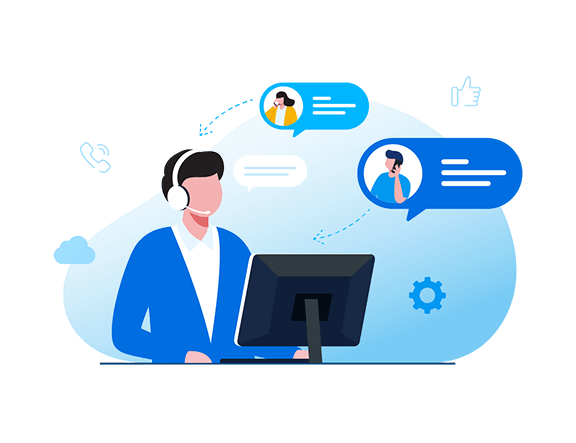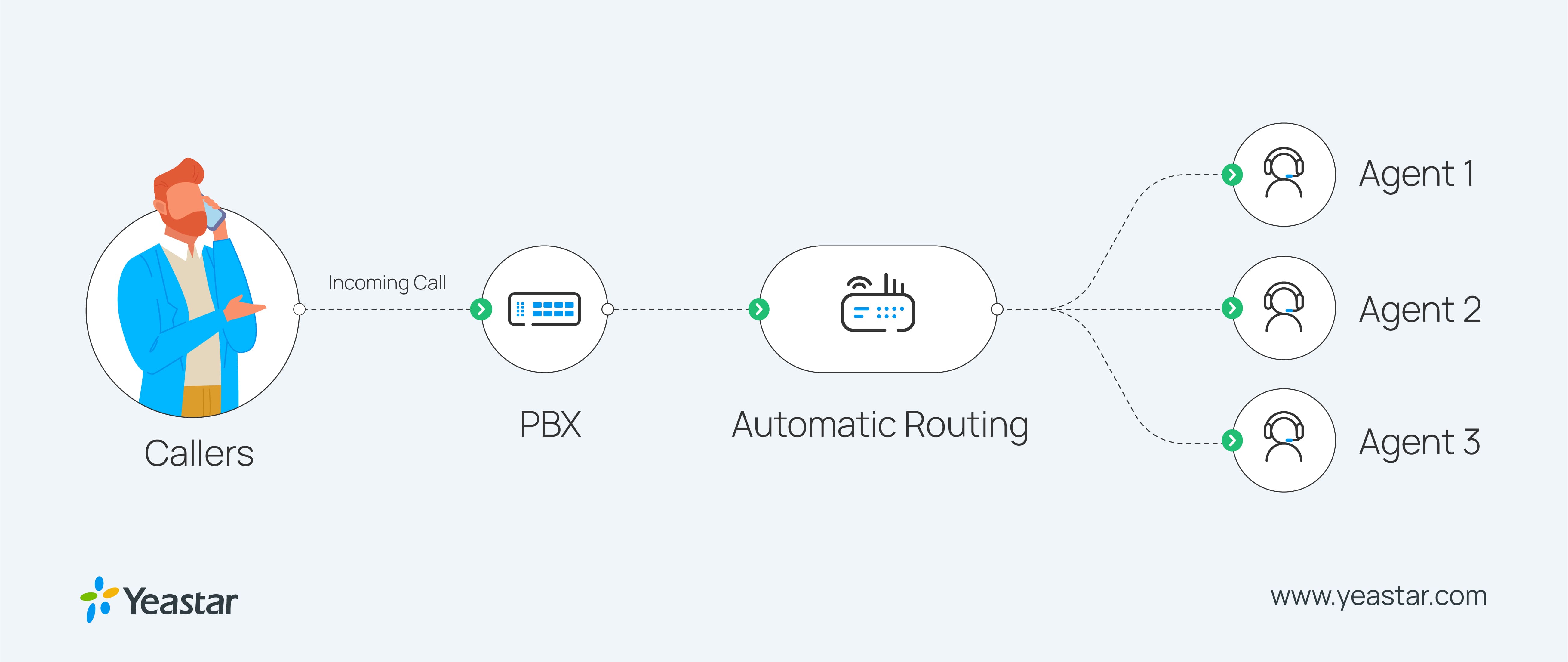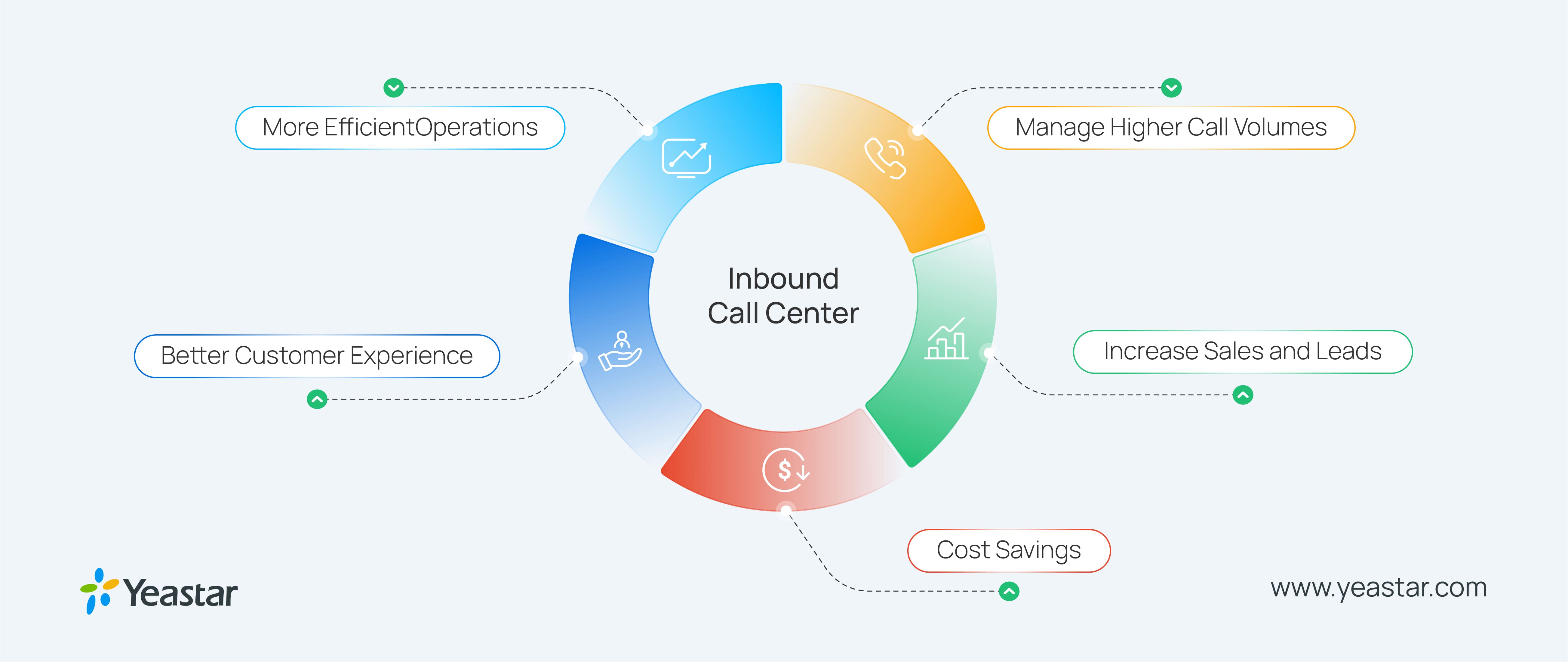 Inbound call centers have been around for a long time, and their purpose is to help businesses connect with customers. Inbound call centers can be used for a variety of purposes, including marketing, customer service, technical support, and sales.
Inbound call centers have been around for a long time, and their purpose is to help businesses connect with customers. Inbound call centers can be used for a variety of purposes, including marketing, customer service, technical support, and sales.
It’s essential for businesses looking to set up an inbound contact center to do their research first to find a reputable call center solution provider that fits the business’s needs.
This article will discuss what an inbound call center does, how it works, its benefits, and how to choose the right solution for your business.
Table of Contents
- What Is an Inbound Call Center? →
- How Does an Inbound Call Center Work? →
- Inbound vs. Outbound Call Centers →
- Key Features of Inbound Call Center Software →
- Benefits of Inbound Call Center Systems →
- Which Industries Can Benefit From an Inbound Call Center Software? →
- How to Choose the Right Inbound Call Center System →
- Yeastar VoIP Inbound Call Center Solution →
What is an inbound call center?
An inbound call center is a type of call center that primarily handles inbound phone calls. They are often used by businesses that receive a high volume of incoming customer calls, such as tech support, sales, customer service, and appointment scheduling. Excellent inbound call center services may improve customer satisfaction by offering timely support and help.
An inbound call center software is a business phone system that takes all your incoming calls for your business and automatically routes calls to the appropriate department or agent based on the information provided by the caller. You will also have access to real-time performance metrics of agents so that you can improve efficiency at all times.
How does an inbound call center work?
Inbound call centers work in many different ways, but the basic process is generally the same. When an incoming customer call comes in, it is routed to the appropriate agent or team of agents. The inbound call center staff then handles the call according to the customer’s needs.

In some cases, the inbound calls may be automatically routed to the next available agent based on factors such as the time of day and the type of call. In other cases, the customer may be placed on hold until an agent is available.
Inbound call centers typically use a variety of software programs and tools to help manage the flow of calls and keep track of customer information. These tools can include call routing software, customer relationship management (CRM) integration, and reporting and analytics tools.
Inbound vs. Outbound Call Centers – What’s the difference?
You’re not alone if you’re not familiar with the difference between inbound and outbound call centers. Many people aren’t aware of the different types of call center services available. In a nutshell, inbound contact centers handle incoming calls from existing customers, while outbound call centers make outgoing calls to potential customers.
An outbound call center is a contact center that primarily makes outgoing calls to customers. Outbound call centers are sometimes referred to as telesales centers. The primary purpose of an outbound call center is to generate leads and sell products or services.
There are certain key distinctions to be made between inbound and outbound call centers. Here are some of the most important ones:
-
An Inbound call center deals with customer inquiries and answers questions, while an outbound call center is focused on selling products or services to customers (cold calls).
-
An Inbound call center is usually associated with a company’s customer service team. Outbound call centers are often associated with a company’s sales team.
-
Inbound call centers typically use VoIP or other software to handle inbound calls. Outbound call centers typically use a predictive dialer to make outbound calls.
-
Inbound call centers are focused on customer satisfaction. Outbound call centers are focused on generating leads and sales.
It’s worth noting that many call centers offer both inbound and outbound call center services. These types of call centers that deal with incoming and outgoing calls are sometimes referred to as omnichannel or multichannel call centers.
Key features of inbound call center software
Inbound call center software typically offers a wide range of features. Some of the most common ones include:
#1 Interactive Voice Response (IVR)
Interactive Voice Response (IVR) systems allow customers to interact with a computer system using voice commands. IVR can handle simple inquiries, provide information, and direct calls to the right department or agent, thereby reducing the workload on live agents and speeding up the resolution process.
#2 Automatic Call Distribution (ACD)
Automatic Call Distribution (ACD) systems intelligently route incoming calls to the most appropriate agent or department based on predefined criteria such as agent skill set, availability, and customer priority. This ensures that customers are quickly connected to the right person, reducing wait times and improving satisfaction.
#3 Call Monitoring
Call monitoring allows managers to listen in on customer calls in real time. This feature is often used for quality control purposes. The customer service manager can use call monitoring to listen for areas where agents need improvement. To ensure exceptional customer service, call monitoring is often used as a way to coach agents on how to handle customer inquiries.
#4 Call Recording
Call recording is used to record customer interactions. Much like call monitoring, it is helpful for quality control and coaching purposes. Additionally, some businesses use call recording to protect themselves from legal liabilities. It can also create a library of customer interactions to train new call center staff.
#5 Call Reporting
Call reporting provides managers with information about how call center agents are performing. This information can include the number of calls an agent has answered, the amount of time they have spent on each call, and the number of customer complaints they have received. Additionally, historical reporting can be used to track trends and spot patterns.
Related: 13 Must-Track Performance KPIs for Call Center Success
#6 Real-Time Wallboard
A real-time wallboard allows managers and agents to see how the call center is performing at any given moment, including the quality and efficiency of each agent’s calls and the overall volume of traffic that comes through the call center. This information can be used to identify areas where the call center needs improvement.
Related: Call Center Wallboard – 5 Benefits and Best Practices Guide
#7 Skill-based Routing
Skill-based routing matches incoming calls with agents who have the specific skills needed to address the caller’s issue. This improves first-call resolution rates and ensures that customers receive expert assistance quickly.
Related: How to Set up Skill-based Routing?
#8 Omnichannel Support
Modern inbound call center software often supports various communication channels, including phone, email, SMS, and social media (like WhatsApp and Facebook Messenger). Omnichannel messaging ensures that customers can reach out through their preferred channel and receive consistent service across all touchpoints.
Related: What is Omnichannel Messaging?
#9 Customized Waiting Experience
You can make customers feel valued while they wait on hold by personalizing their waiting experience. Regular updates on wait times and position in the queue keep customers informed, reducing anxiety and frustration. Personalized messages and music can also be played to improve the waiting experience. Additionally, consider offering a queue callback option, allowing customers to request a callback instead of waiting on hold.
Related: Explore how Yeastar empowers you to create customized waiting experiences
#10 Self-Service Options
By linking automated IVR with self-service instructions, customers can help themselves without agent involvement, significantly speeding up the call process. This reduces call volumes and allows agents to focus on more complex issues.
How to effectively utilize inbound call center software?
Inbound call centers play a vital role in delivering exceptional customer support. Here are three key areas where they excel:
Providing Technical Help
Inbound call center agents offer tech support and can route customers to specialized support teams if needed, ensuring comprehensive assistance for all technical inquiries.
Addressing Complaints
In challenging situations or when customers encounter difficulties, inbound call center agents play a crucial role. Agents may receive calls from customers to complain about any issues. They respond promptly and professionally to customer complaints, aiming to resolve issues effectively and restore customer satisfaction.
Order Processing
Inbound call centers efficiently manage order requests, ensuring accurate details are captured and processed promptly. From order placement to tracking shipments, call center agents ensure a seamless experience for customers, minimizing errors and delays.
Benefits of inbound call center systems
Taking advantage of inbound call center solutions can provide many benefits for your business. An Inbound call center can provide your business with many advantages, from increased customer satisfaction to lower operating costs.

Here are five benefits of using an inbound call center for your business:
Better Overall Customer Experience
Every customer wants to feel that they are being taken care of, and this starts with the first contact. Call center systems can help route calls to the right agent, monitor calls, and record them for later review. This helps improve customer service by reducing wait times and improving call quality, while also helping with retention rates because customers will be more satisfied with their interactions with your business.
More Efficient Operations
Equipped with the right tools, employees will have more time to focus on customer service, allowing them to improve both service quality and speed, which translates into improved customer retention rates. A well-designed inbound call center system can also help you lower overall operating costs by reducing agent turnover rates and improving productivity levels through better training programs.
Easier Management of Higher Call Volumes
If you have a business that experiences high call volumes, an inbound call center can be a great solution. This is because they are designed to handle large amounts of calls without sacrificing quality. It means that your customers will still be able to get the help they need, even during peak times.
Increased Sales and Leads
Though outbound services are typically used to generate leads and sales, inbound services can also help. This is because they can provide a higher level of customer service, meaning that your customers will be more likely to do repeat business with you if they feel like they are being taken care of. A happy customer is also likely to share their good experiences with others, leading to more word-of-mouth marketing for your business.
Cost Savings
An Inbound call center can also provide cost-saving benefits for your business. They can manage their resources more efficiently, which leads to lower costs. Additionally, businesses should consider using a cloud call center to help further reduce costs. Cloud-based solutions are becoming more and more popular due to the many benefits they offer, such as scalability and affordability.
Which industries can benefit from inbound call center software?
Many businesses can benefit from using an inbound center, below are just a few examples.
Healthcare
It is vital to provide patients with high-quality customer service in the healthcare industry. An Inbound call center can be beneficial for a healthcare business, as they can manage patient calls, schedule appointments, and handle other administrative tasks. A call center can help improve patient care and reduce the workload for employees.
Financial Services
Financial service businesses often have high call volumes, as customers need help with various tasks such as opening accounts, transferring money, and more. An inbound center can be an excellent solution for these businesses as they can manage high call volumes and provide quality customer service.
Retail
It is important to provide customers with a positive shopping experience and outstanding customer service as a retailer. An inbound call center can help do this by handling customer orders, returns, and complaints. Additionally, an inbound call center can also help to increase sales by providing product support and handling orders.
Ultimately, any big/small business can benefit from an inbound call center by having a dedicated team of professionals handling customer service inquiries.
How to choose the right inbound call center service for your business?
There are several things to consider when choosing the best service for your business, as it is not a decision to be taken lightly.
What are the initial and ongoing costs?
The three main factors that impact the overall cost include:
-
Hardware costs (headsets/phones/other equipment)
-
Software costs (licensing fees and maintenance)
-
Training costs (on-site or online training)
In addition to these three main factors, you should also consider how much downtime you can tolerate during the implementation process. A poorly chosen inbound call center system may cause more frustration than it’s worth if it causes your team to lose productivity while they learn how to use it properly.
Does the feature set address your specific needs?
When it comes to functionality, not all systems are created equal. Make a list of the features you need and those that would be nice to have but you can live without. It will help you focus on what is important and avoid wasting time on features that are not necessary or do not suit your needs. Be sure to understand how to use the features you choose.
Are you looking for an on-premise or hosted solution?
When you choose a hosted system, all of the services and updates are managed by the provider of your inbound call center system, which can benefit businesses that have limited IT resources. As for a premise-based solution, the system resides at your location, meaning you stay in complete control of it and are also responsible for maintaining everything from updating security patches and running backups on servers to keeping equipment running smoothly.
Is it compatible with your current equipment?
Before opting for call center software, it is important to consider the current hardware that you have in place, such as headsets and IP phones. Whether or not those devices can be used with the new system? There may be costs associated with replacing existing equipment as part of transitioning into a new platform.
Elevate Your Customer Service with Yeastar
Yeastar P-Series Phone System gives full backing. It provides an all-in-one call center solution that includes all the essential features – ACD queuing and distribution, IVR, visual call management, call recording & monitoring, reports, and more. The intuitive Queue Panel allows you to monitor queue traffic, and check & switch agent status, which can improve the work efficiency of the agents and supervisors. Also, you can discover real-time call center metrics and other data from the central call center Wallboard to track agent performance and analysis.
The full-featured solution can help you power customer service sophistication and operational efficiency, and help businesses of all sizes impress their customer, empower their agents, and elevate their business.

